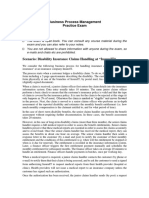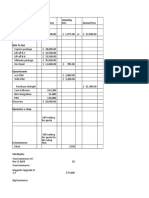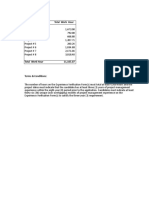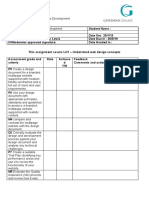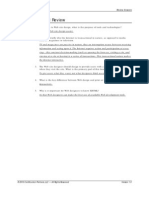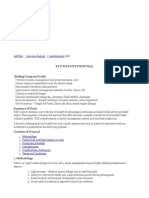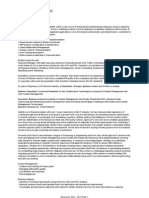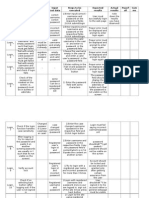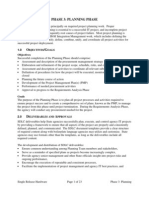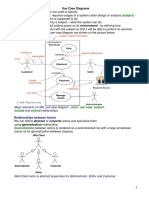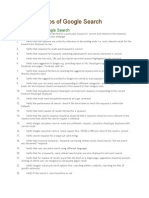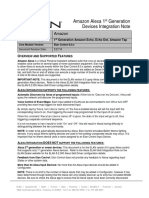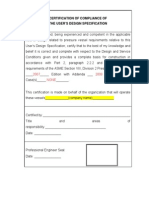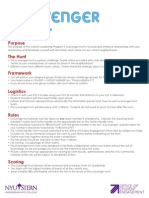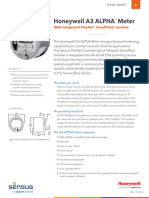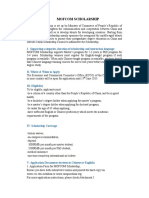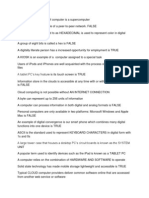Fanshawe College Liz G.
The Tea Haus
Report on Google
Analytics
December 7th 2012
�Contents
Visits, pageviews and bounce rate changes by Country / Region............................4
Engagement............................................................................................................ 7
Mobility / Device Usage........................................................................................... 7
Browser Usage........................................................................................................ 9
Pageviews by URL................................................................................................. 13
Bounce Rate by Landing page Filter Visits >100...................................................14
Meta-titles............................................................................................................. 15
Canonicalization and Duplicate Content................................................................17
Sites with highest amount of referral traffic (Filter >50)..........................................22
High quality and low quality traffic...........................................................................24
Organic Traffic by Keyword....................................................................................... 27
Non-Branded Keyword Traffic....................................................................................28
Keyword Specific Landing Pages............................................................................... 29
Report Introduction
A Three stage Approach
Within the enclosed report, extensive analysis is done within three areas pertaining to The
Tea Haus google analytics. The report is broken down into three key areas:
1. Audience Metrics
2. Content Metrics
3. Traffic Sources
By better understanding the data from these three areas within google analytics, The Tea
Haus can expect to not only better understand the types of users that visit their website, but
understand how they consume content as well as where the sources of this traffic comes
from.
While this report provides recommendations that the Tea Haus can make immediately to
help improve these metrics, this sort of analysis should be done on a semi-regular basis, as
�changes that are made must be monitored for success, and then reassessed to ensure
optimal website usage by The Tea Haus users.
Part A: Audience
Metrics
Analysis needs to be made continually on these metrics as they are deemed
important. By tracking changes in Audience Metric data, The Tea Haus can get
a head start responding to user changes, website usability issues, and finally
customer engagement, geographical, and technology trends
�Introduction
For the Audience Metrics section of the report, we have decided to structure our analysis to
answer three basic questions:
1. Which demographics are visiting the site and how have these numbers changed
over time.
2. What is the engagement level of users as they visit the site? Which users are
most engaged and how to do they engage with the website.
3. How do customers use technology (Browsers & Devices) to visit the website?
How has this changed year-over-year, and what implications do these changes
have.
By presenting some basic audience metrics and understanding how they have changed over
time, we hope to provide insight on why these metrics are important, how they should be
monitored as more data comes in, and most importantly how these metrics should guide any
changes made to The Tea Haus website in the future.
It is important to highlight that we have selected two time-periods to evaluate data. First,
March 1st, 2012 Sept 25th, 2012. This date is the longest period which we can get a yearover-year comparison. Second, we have selected Sept 26th, 2011 Feb 29th, 2012. This
time-period holds data that surrounds high-volume seasonality trends through the winter
season.
Seasonal data has been excluded from this section of the report. While number of
visits/visitors increases dramatically, for the purpose of studying audience, overall ratio of
new/returning, as well as location and technology users have shown little to no difference.
�Demographics
Visits, pageviews and bounce rate changes by Country / Region
What
Region is
most
Total
Page
Page
How has
Total
traffic
Visit
View
View
traffic
---Visits
coming
s
s
s
changed
2012
from in
2011
2011
2012
from 2011?
2012?
(total
visitors)
Canad
8,12 13,01
Ontario
Ontario
8.5
7.38
a
0
8
8,153
+40.67%
BC
BC
1,374
+107.55%
Quebec
Quebec
1,285
+156.49%
Alberta
Alberta
+80.81%
1,112
United
2,48
Michiga Michigan
1,093
4.59
6.91
States
4
n 162
+116%
California
California
(-59.17%)
98
New
New York
York 87
(-59.35%)
How has the
Region Bounce
Rate changed
from 2011?
Ontario up
+3.12%
BC up
+3.24%
Quebec up
+18.33%
Alberta (6.67%)
Michigan
(-16.56% )
California up
+8.62%
New York
(-26.72%)
Visits and Pageviews by City
City
London
Toronto
Montreal
Vancouver
Calgary
Visits
2,855
1,826
761
495
463
Pages / Visit
7.49
6.87
5.86
3.96
6.49
In 2012, most traffic (by total visits) is coming from cities in Canada:
1.
2.
3.
4.
5.
London: 2,855
Toronto: 1,826
Montreal: 761
Vancouver: 495
Calgary: 463
Based on the data provided from March 1st 2011 to September 25th 2012, the Tea Haus has
seen a significant increase in visitors from the Canadian market, and there has been a large
decrease in visitors from the United States.
�The geographic region that pulls the most traffic is definitely Canada, of course because Tea
Haus is a Canadian based company. More specifically London Ontario, being that this is the
Tea Haus home, this makes perfect sense. The Tea Haus has done something significant for
serving its Canadian market because in all cases, visits have been increasing. Although
engagement levels fluctuate, in many cases (e.g. Tronto +91%, Montreal - +157%,
Vancover +170%) visits have doubled from 2011-2012.
While the amount of time that the Canadian market is staying on The Tea Haus page has
decreased, perhaps the site is allowing users to find the content they are looking for than it
was in the previous period. The most important metric to be paying attention to in this case
is conversion rate, and engagement should be watched to determine if interest in content is
waning. If the Tea Haus saw a correlation between these engagement metrics and
conversion rates, one suggestion could be to allow consumers to do things such as, create
their own drink online, or learn to pair your favorite tea with the appropriate healthy snack
and so on.
Engagement
Returning and Unique Visitors
New Visitor
Visits
Visit %
Mar 25, 2012-Sep 25, 2012
9,645
71.51%
Mar 25, 2011-Sep 25, 2011
7,449
66.46%
Mar 25, 2012-Sep 25, 2012
3,843
28.49%
Mar 25, 2011-Sep 25, 2011
3,759
33.54%
Returning Visitor
The Tea Haus is seeing positive trends in the amount of new visitors to their site. From
5/25/12 to 9/25/12 The Tea Haus had 9,645 new visitors, in comparison to the same time
period in 2011 that saw 7,449 new visitors, an increase of 29.5%. With an excluded bounce
rate the visits still show a growth of 25%. Returning visitors is showing a slightly lower level
of positive growth. From 5/25/12 to 9/25/12 The Tea Haus had 3,843 returning visitors, the
same time period in 2011 had 3,759 returning visitors, an increase of only 2.2%. However
with an excluded bounce rate growth in returning visitors is 19.1% over the previous year.
�The Tea Haus has been effective at growing their online presence, but the returning visitors
should show growth similar to that of new visitors. Based on ecommerce conversion
metrics, returning visitors are much more likely to result in a conversion. Because of this,
The Tea Haus should not lose sight of the fact that bringing customers back to the sight is
just as important as making sure they enjoy their current visit. As shown in the screenshot
below, the Tea Haus newsletter signup form is not only located at the bottom of the page,
far below the fold (below the sites viewable area at entrance), but it gives no reason to
subscribe. A simple description about whats included and what sort valuable content is
provided could increase subscriptions, and potentially conversions.
��Engagement
Pages per visit
(Excluding Bounce)
Average time on
site (excluding
Bounce)
Mar 1, 2011 - Sep 25,
2012
11.8
7:35
Mar 1, 2011 - Sep 25,
2011
11.31
6:11
The Tea Haus has had a high amount of pages per visit in metric in both the 2011 and 2012
time frames and has not changed drastically since 2011. The pages per visit metric is
understandable given the number of pages the customer must follow to progress through
the website toward checkout. Though page per visit has showed identical metrics The Tea
Haus has seen a decrease in average time on site at a percent of -18:33%. A correlation
between time on site and pages per visit might be expected, but it is possible The Tea Haus
has made the navigation on their site easier for visitors. In addition returning visitors will
become increasingly more comfortable with the site, which would also account for the
decrease in average time on site. With the high number of pages per visit it is safe to
assume visitors are still going through the buying cycle. The main outcome The Tea Haus is
looking for is a purchase, an decrease in average time on site means visitors are reaching
the conversion point at a quicker rate than before.
Technology Use
Regarding Audience Metrics and technology, four metrics we have measured are Page Views,
Bounce rate, and the percentage of total views per variable. The three variables we have
analyzed are Browser Type, Mobile Use, and Mobile Device Types.
Mobility / Device Usage
As shown below, mobile visits have grown at a significantly higher rate than overall site
visits. From 2011-2012, mobile visits represented 4.6% (2011), and then 10.9% (2012) of all
visits to www.theteahaus.com. This represents a growth rate of 224% in mobile visits,
�compared 28% for overall total visit growth. Bounce rates for mobile devices are slightly
higher, but not significantly higher than overall site bounce rates (48% and 41%). While
some of this growth can be accounted by the increased adoption rates and usage of
Smartphones, The Tea Haus should consider treating mobile and desktop visits very
differently.
For the period Mar 1, 2012 Sep 25, 2012, over 10% of all visits are mobile. Recently,
ThinkwithGoogle published data that says 77% of consumers with smartphones use a mobile
device while inside of a store, and 67% of consumers with smartphones use them while
actually in a Caf or Coffee Shop (www.thinkwithgoogle.com, 2012).
If mobile views are growing, and users are actively using their smartphones on site, The Tea
Haus should consider re-directing these visitors to a mobile site with landing pages catered
to mobile users. This would optimize customer experience, and most likely engagement.
�The most interesting part about the mobile data was that the top three devices used are all
apple products. These devices do not differ significantly in bounce rate from the overall site
average. The implication of these numbers is huge. The site should certainly be touch
friendly if they arent already, and any mobile site should be tested for, or even catered to
iOS users.
�Browser Usage
Taken from the Browser & OS metrics page for the dates Mar 1 - Sep 25, 2011-2012, the
data below shows very clearly that while Safari visits are bouncing at a relatively healthy
rate, when compared to other Browsers, there is room for significant improvement. Safari
users represent almost 25% of all visits, yet are bouncing at a rate 10% higher. This may
not seem like a large number but if Safaris bounce rate would have dropped from 52% to
the average rate of 40%, the site would have realize over 500 new visits over the period.
Browser
Date range
Visit
Bounc
e Rate
Visitors
Average
lost to
visitors lost
Bounces
to bounce
Mar 1, Sep 25,
Internet Explorer
2012
Mar 1, Sep 25,
4,532
36.80%
1667.776
Firefox
2012
Mar 1, Sep 25,
3,817
40.56%
1548.1752
Safari
2012
Mar 1, Sep 25,
3,709
52.31%
1940.1779
Chrome
2012
3,184
39.23%
1249.0832
Mobile user engagement is stable. Page views have increased relative to visitor increases
and in fact, average time on page is at par with non-mobile visitors, which is good. Its
possible that a lack of usability for mobile users is skewing the accuracy of the average time
on page, increasing because it physically takes more time to navigate via a smartphone
�rather than a desktop unit. Further analysis needs to be done from a user perspective
before actions can be taken.
Pages /
Pageview
Avg. Time on
Visit
Page
Mobile
date_range
Visits
13,92
No
Mar 1- Sep 25, 2012
7.18
100,043
0:00:35
6
11,09
No
Yes
Yes
Mar 1- Sep 25, 2012
Mar 1- Sep 25, 2012
Mar 1- Sep 25, 2012
7.28
5.02
4.63
80,812
9,628
2,725
0:00:42
0:00:44
0:00:41
7
1,917
589





